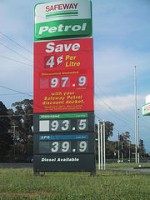
Post from Guest Contributor Chris Blanton, editor of Ingenious Business Guide.
Here is the situation. A loyal customer walks into your business and gets whatever he wants. While paying the bill he asks for a discount. So what do you do? Do you: 1) give in and feel uncomfortable; or 2) refuse and risk losing a client.
The other day I was at the service station D & S Auto in Santa Paula, California where I took my car in for an oil change. When Denny, the owner accepted my payment I inquired “Are you running any specials?” He admitted he wasn’t. So I pushed him: “Can I get a discount?” He looked down at the floor, obviously uncomfortable, and then caved agreeing to knock $5 or 8% off the normally $40 job.
I asked him why he had acquiesced to the discount and whether he felt good about it. He confessed he felt bad but didn’t know how to deal with the question without risking upsetting a customer. “Besides,” he added “$5 isn’t that much.” But by giving in, he would have given away all his profit.
Let’s look at the impact of what seems like a paltry $5 discount. Denny employs a skilled mechanic at roughly $40/hour. He pays payroll taxes and benefits on top of the $40 hourly wage but we’ll ignore that to keep it simple. The oil change took half an hour so my job cost him at least $20.
We have to apportion overhead. One might argue that the company has to pay rent and utilities, office supplies, telephone, advertising regardless of whether he accepts my job but that would be incorrect. My oil change takes up space on the floor and costs the mechanic’s time. Denny can’t resell this time- another job requires another bay and another mechanic. And he has a finite number of bays which limits his capacity. So let’s allocate $10 for the overhead expense. So far his costs are $20 plus $10 = $30.
There are also hidden costs: the cost of interest on bank loans and credit cards, bad debt, equipment, and any other unexpected or unusual costs eat up profits. These costs easily make up at least 5% of gross sales, and it’s probably closer to 10%. Let’s use the lesser figure of 5% of the $40 which is $2. That leaves $8 remaining. Taxes take a third leaving a net profit of $5. So by Denny giving that to me, he agreed to relinquish all his profit. Scary, huh?
There’s a better way: give a discount in a way that satisfies the customer and increases the net profit of the sale. How? By introducing a discounted upsell. An upsell is when the drive-in asks you “Do you want fries with that burger?” You give a discounted upsell by discounting the additional purchase.
Instead of shaving profit off an already booked sale, offer an additional purchase at a discount. In the case of my oil change, Denny could have offered to rotate my tires and knocked off $5 for the extra service. That way the firm books additional profit for more work (assuming the services are priced profitably) and the customer feels satisfied that the company made a concession. Most importantly: you never want to refuse a customer. Always change the situation so you offer them the choice to refuse your offer. Incidentally, I paid full price for the service.






